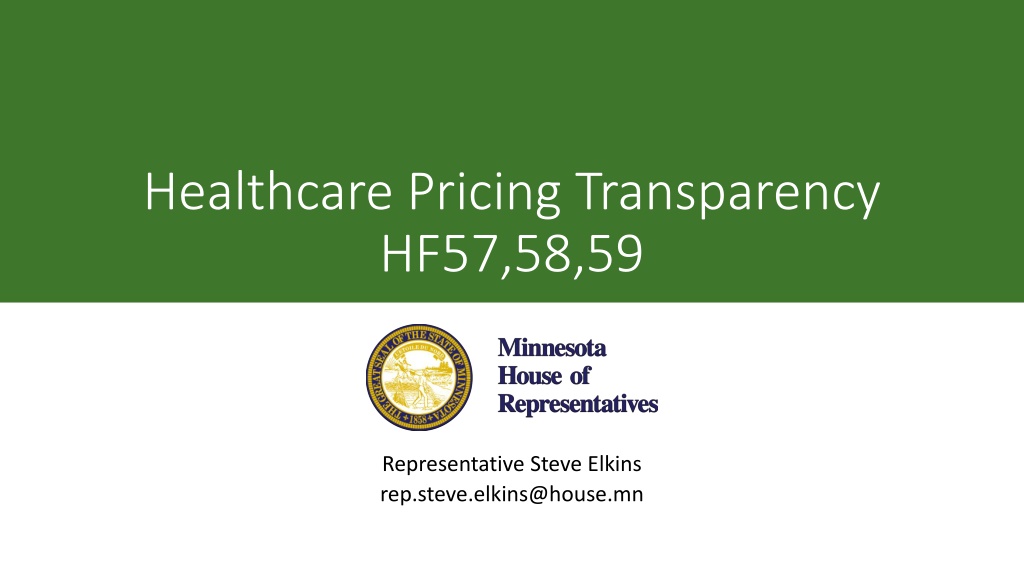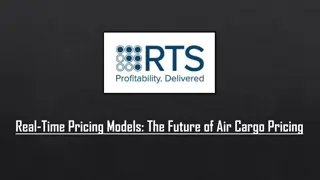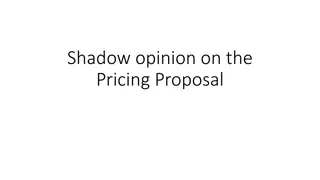Healthcare Pricing Transparency Bills Overview by Representative Steve Elkins
In this informational piece by Representative Steve Elkins, the focus is on discussing healthcare pricing transparency bills HF57, HF58, and HF59. These bills aim to reveal list prices, actual price ranges, and reimbursement rates for drugs, hospitals, and various healthcare services. Emphasizing the need for transparency, the content explores why healthcare pricing should not be a hidden cost to consumers, drawing attention to the importance of knowing prices upfront. Credits are given to organizations involved in advising and developing the bills, shedding light on Minnesota's All Payer Claims Database and the efforts to improve data accessibility and accuracy.
Download Presentation

Please find below an Image/Link to download the presentation.
The content on the website is provided AS IS for your information and personal use only. It may not be sold, licensed, or shared on other websites without obtaining consent from the author. Download presentation by click this link. If you encounter any issues during the download, it is possible that the publisher has removed the file from their server.
E N D
Presentation Transcript
Healthcare Pricing Transparency HF57,58,59 Representative Steve Elkins rep.steve.elkins@house.mn
Overview The Big Picture
Why? Is there anything else that we buy that can cost us hundreds or even thousands of dollars where we would feel like it s normal and acceptable to place our order with the understanding that we ll only learn what the price is going to be after we ve taken delivery, while accepting an obligation to pay whatever price is asked after the fact? Why do we accept this when buying healthcare?
The Big Picture HF57 HF 58 Drugs Hospitals & Shoppable Services Builds on CMS Hospital Pricing Rule Reveals List Prices and Actual Price Ranges Chargemaster List Price Self Pay Price Median Reimbursement Rate Min/Max Rate Builds on HF 1246 (Morrison) Reveals List Prices Wholesale Acquisition Cost (WAC) Average Wholesale Price (AWP) Comprehensive Healthcare Price Reporting Medicare Drug Spending Data Medicare/Medicaid Reimbursement Rates Public Information HF 59 Public Information Services & Drugs Builds on Existing All Payer Claims Database Reveals Prices Paid on Actual Claims
Credits Thanks to the Staffs of these Organizations for their advice and assistance in the development of these bills: NCSL (National Conference of State Legislatures) NASHP (National Academy for State Health Policy) United States of Care Minnesota Department of Health Minnesota Department of Human Services
HF59 All Payers Claims Database Steve Elkins | Representative HD 49B
Minnesota All Payer Claims Database The All-Payer Claims Database (APCD) is a repository of healthcare claims records submitted to MDH by Minnesota Health Plans. APCDs are promoted under federal law, and many states have them Their purpose is to support medical research and reporting All APCD data is de-identified all Personally Identifiable Information (PII) has been stripped out. Usage of the Minnesota APCD has been limited because, under current State Law Only semi-annual submissions are required so much of the data is stale Some plan administrators withhold data from employer financed ERISA plans, so the scope of the data is incomplete. APCD data cannot be used for price reporting because of earlier negative experiences with using stale, incomplete data for this purpose. (Provider Peer Group reporting)
Objectives of HF 59 Improve latency of the data by requiring monthly submissions Most health plans already do it s actually easier because the data volumes are more manageable Leverage language in Federal No Surprises Act encouraging the submission of ERISA plan data to improve the scope of the data. Allow the improved data to be used for reporting of actual pricing by procedure and provider Reporting by both provider and health plan is prohibited by federal law to preserve the confidentiality of negotiated rates. Supplement the reporting of published price data required by HF 57 and HF58. Note: Congress has appropriated a grant of $2.5 million per state to fund these types of initiatives
HF 59 Key Stakeholders The Key Stakeholders consulted in the Development of HF58 include: Minnesota Department of Health Minnesota Hospital Association Minnesota Medical Association Minnesota Chamber of Commerce Testifiers Minnesota Department of Health Minnesota Medical Association Minnesota Chamber of Commerce
HF57 Hospitals & Shoppable Medical Services Steve Elkins | Representative HD 49B
HF 57: Shoppable Medical Services Prices The foundation of HF 57 is the second version of the CMS Hospital Price Transparency Rule, first enacted in 2018. The new version of the Rule was effective Jan 1, 2021 and requires hospitals to post the following information on their websites: Their Chargemaster list prices for each service Their Cash Prices for the uninsured for each service The Median Price received by the hospital for each service The Minimum and Maximum Prices received by the hospital for each service The current reimbursement rates for each health plan for that service in a Machine Readable format (Excel, CSV, ) that can be imported into a spreadsheet or database.
HF 57: Shoppable Medical Services Prices Problem: Each hospital is posting the data in its own unique format, which thwarts the use of the data for price comparison purposes. Hennepin Health HCMC file Layout Allina Abbot Northwestern file layout: ?
HF 57: Shoppable Medical Services Prices The Solution: Require all hospitals to use the same format for their Machine Readable files Require hospitals to transmit these files to the MN Dept of Health Fund the MN Dept of Health to compile the files into a single database for comparison purpose, focusing on the creation of price comparisons for Shoppable Services (e.g., Imaging, Orthopedics) Extend the requirement to other providers of these shoppable services (e.g., Orthopedics, Radiology, etc.)
The Goal of HF57: Comprehensive, Accessible and Understandable Health Care Prices for Patients The CMS Rule also requires a display of shoppable services in a consumer- friendly format. This presentation of price information for a selection of Shoppable Services by Health Partners/Park Nicollet is exemplary in its presentation; however, only a limited number of prices are presented.
HF 57 Key Stakeholders The Key Stakeholders consulted in the Development of HF57 include: Minnesota Department of Health Minnesota Medical Association Minnesota Hospital Association Outpatient Surgical Centers Specialty Medical Practices Orthopedics (e.g., TCO) Radiology (e.g., CDI) Testifiers Minnesota Hospital Association
HF58 Drug List Prices Steve Elkins | Representative HD 49B
Progression of Drug Price Regulation Bills 1. 2019 HF Mann PBM Regulation 2. 2020 HF Morrison Drug Price Transparency 1 3. 2020 HF Elkins Drug Price Transparency 2 4. 2020 HF Cantrell Drug Formulary Stabilization 5. 2021 HF 58 Elkins Drug Price Transparency 2 Drug Formulary Stabilization Under HF 58 both Manufacturers and PBMS/Plans would be required to file their offerings in advance and honor them for the duration of the next calendar year.
The Annual Health Plan Development Cycle When consumers enroll in a health plan during Fall open enrollment, the inclusion of their prescribed drugs in each Plan s formulary at a particular price point is a key decision criteria. Consumers have right to expect that the representation of their drug s coverage will be honored over the course of the plan year by the Plan and its Pharmacy Benefit Manager (PBM). Plans and their PBMs cannot honor that commitment, while maintaining reasonable premiums, unless the Manufacturers are also bound to honor price commitments over the same period. Manufacturers Set WAC Plans Become Effective and Patients Submit claims PBM Negotiates Discounts/Rebates with Manufacturers Patients Select Plans during Open Enrollment Insurers Develop and File Plans with Commerce Dept
The Essence of HF58- Price Transparency Every January, as soon as the Plans and their Formularies are locked in, the drug manufacturers all raise their prices. How can we expect the Plans and their PBMs to honor their drug formularies when the manufacturers raise their prices as soon as the Plans go into effect? HF57 would require the Manufacturers to notify the Plans and PBMs of their price increases, in advance, (Article 1) so that the Plans and PBMs can bake next year s drug prices into their plan formularies and then honor them (Article 2). HF57 does not restrict the ability of Manufacturers to set their own prices.
Drug Price Filing Requirements of HF58 HF 58 Requires Drug Manufacturers to notify the Minnesota Department of Health of their list price increases in advance and directs MDH to publish those prices to the public WAC (Wholesale Acquisition Cost) Nominally, the Wholesale Acquisition Cost is the List Price for sales by the Manufacturer to Wholesalers. In practice it is also the reference price used to calculate discounts, rebates and commissions throughout the drug value chain. AWP (Average Wholesale Price) Nominally, Average Wholesale Price is the Suggested Retail Price of the drug. In practice, it roughly guides the price at which the Wholesalers sell to the Retailers and the PBMs reimburse the Retailers. Both WAC and AWP are starting points for negotiation Both WAC and AWP are established by the Manufacturers Over half of brand name drug purchases by patients are at prices tied to the WAC through co- insurance payments expressed as a percentage of the WAC. These reference prices are widely disseminated throughout the trade by drug data aggregators such as First Data Bank and Wolters-Kluwer (Medi-Span) They are not Trade Secrets in any sense of the word
WAC and AWP in The Pharmaceutical Value Chain The Drug Value Chain is exceptionally complex. Drug Manufacturers only net about half of their gross Wholesale Acquisition Cost (WAC) on average. Much of the balance is absorbed by the myriad of intermediaries in the value chain that lie between the manufacturer and the patient. At every step in the process, the discounts, rebates or commissions earned by intermediaries are expressed as a percentage of the WAC or the AWP (Average Wholesale Price). Over half of all patients prescribed expensive brand name drugs pay a coinsurance amount that is expressed as a percentage of the WAC. GPO GPO PSAO GoodRx
Outstanding Issues Exclusion for wholesaler convenience repackaging operations Access to specified drug codes ATC (Anatomical Therapeutic Chemical Class) Non-Proprietary (WHO Standard) Most Manufacturers don t carry ATC in their own databases GPI (Generic Product Identifier) Matches chemically identical drugs Proprietary to Wolters-Kluwer (Medi-span) There may be licensing issues Most Manufacturers don t carry GPI in their own databases Should Generic Drugs be excluded?
HF 58 Key Stakeholders The Key Stakeholders consulted in the Development of HF58 include: Minnesota Department of Health Pharmacy Benefit Managers Prime Therapeutics Cigna/Express Scipts OptumRx Health Plans Health Partners Blue Cross/Blue Shield MN Manufacturers PHrMA Generic Manufacturers Wholesalers Amerisource Bergen Testifiers Prime Therapeutics
HF 58 Reference Materials The Prescription Drug Landscape, Explored (Pew Trusts) A TANGLED WEB: AN EXAMINATION OF THE DRUG SUPPLY AND PAYMENT CHAINS (US Senate Report) Report of the Minnesota Attorney General s Advisory Task Force on Lowering Pharmaceutical Drug Prices (MN Attorney General) Drug Channels (Adam Fein) Patients for Affordable Drugs























